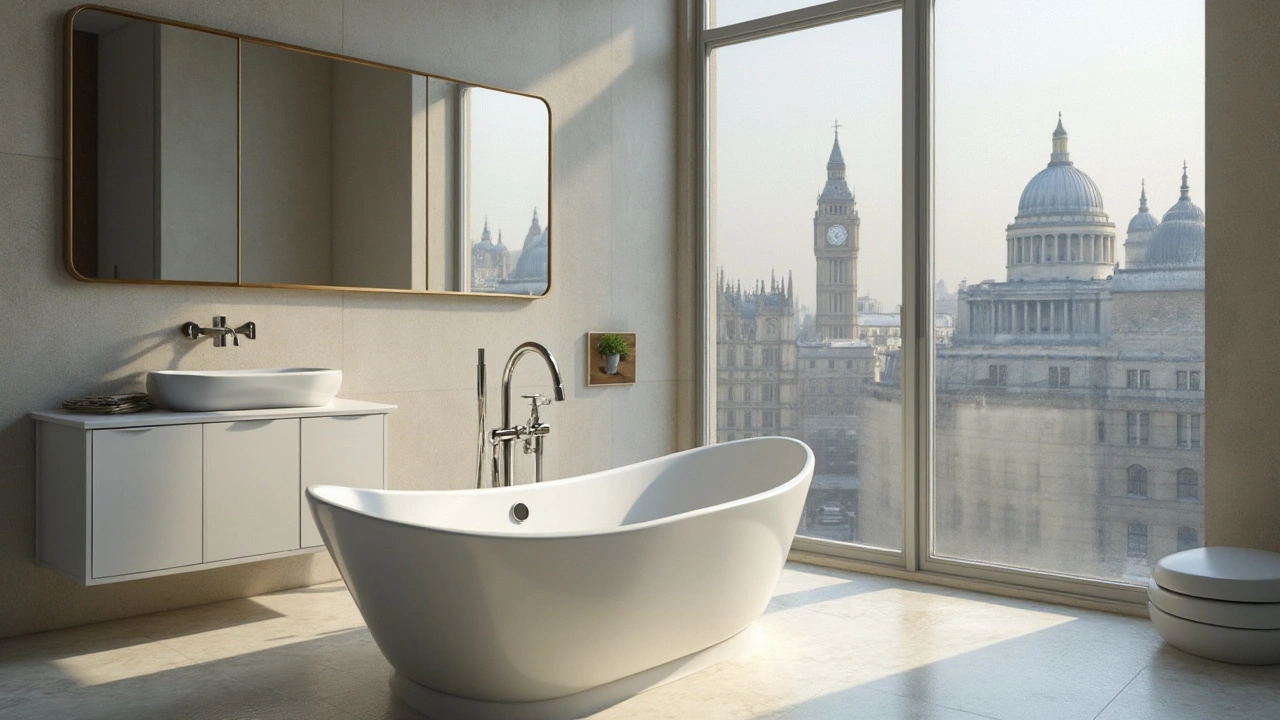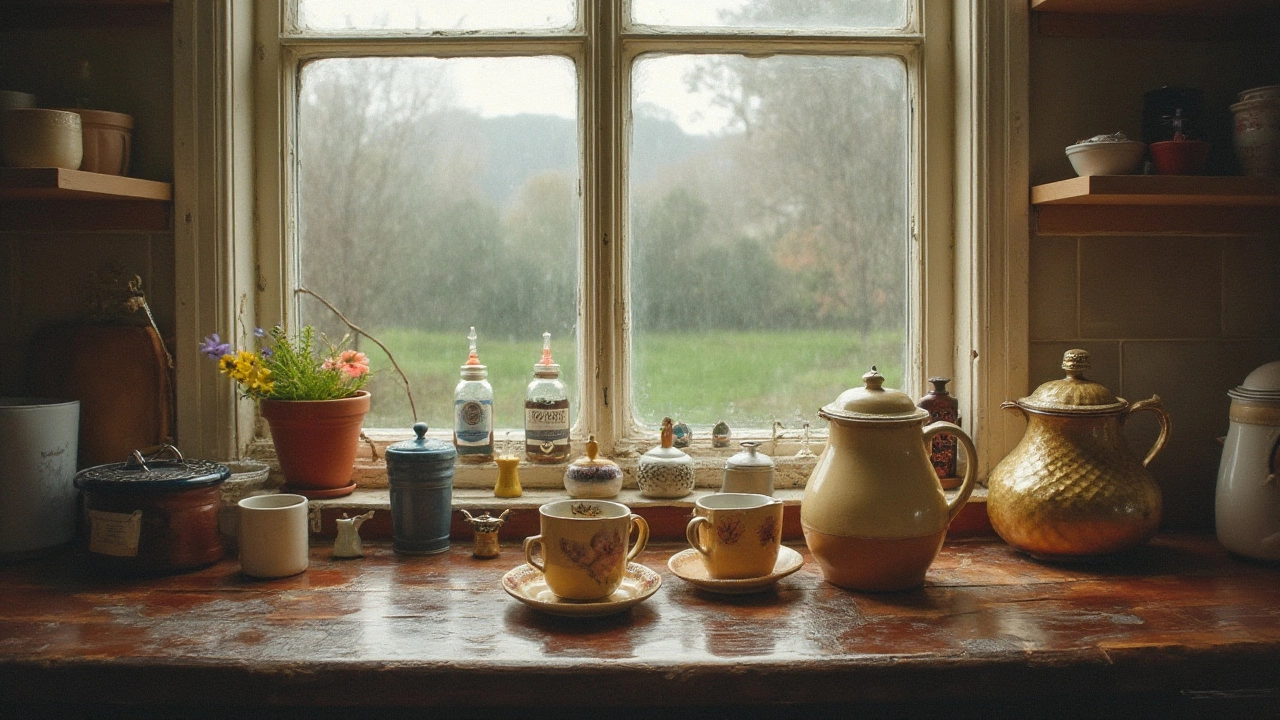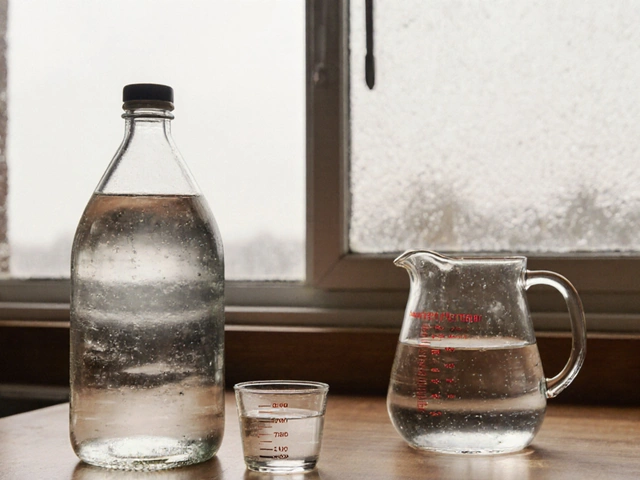Limescale might seem like a small detail, but it can cause notable disputes during the end of tenancy checks. As we wade through this topic, it's essential to grasp whether limescale buildup falls under fair wear and tear or if tenants must tackle it. This mineral deposit is notorious, particularly in areas with hard water, stealthily covering surfaces and appliances over time. Understanding how it forms and which household items it's fond of hiding on is the first step in managing its presence effectively.
In this piece, we’ll delve into the nitty-gritty of limescale—what triggers its formation, how it ties into tenancy agreements, and if tenants should add it to their cleaning checklist before leaving a place. We’ll lay out practical tips for removing it and discuss ways to prevent it outright. As we unpack these facets, both tenants and landlords can better navigate the tenement's bill of health, aiming for conflict-free handovers.
- Understanding Limescale
- Causes of Limescale Build-up
- Limescale and Fair Wear and Tear
- Removing Limescale Effectively
- Preventive Measures Against Limescale
- Tenant and Landlord Responsibilities
Understanding Limescale
Limescale, in essence, is a chalky white deposit composed primarily of calcium carbonate. It emerges wherever water has passed and evaporated, leaving behind mineral deposits. Whether you're a tenant or a landlord, understanding limescale is crucial to maintaining cleanliness and managing expectations regarding wear and tear. Hard water, which contains a high concentration of calcium and magnesium salts, is the primary culprit for limescale formation. When this water heats up, say inside kettles and boilers, the minerals dissolve and settle as limescale.
It's no surprise that limescale loves living inside plumbing systems, on bathroom surfaces, and even inside the washing machine. The sneaky deposits clog up showerheads, reducing water flow, and mar the shiny surfaces of faucets with a rough, unappealing texture. Among the locations it most frequently nests, kitchen appliances such as kettles and dishwashers, and our most frequented rooms—the bathrooms—top the list. Notably, limescale is a tougher beast in regions with hard water. An insightful fact from the UK's Water Research Council states that over 60% of households in the UK receive hard water, which makes understanding and managing limescale essential.
Limescale isn’t just about aesthetics; it can impact the efficiency of your appliances too. Did you know that a mere 1.6mm coating of limescale on a heating element can decrease energy efficiency by up to 12%? This is because the heating element spends more energy heating the limescale than the water itself. As tenants, facing a bit of limescale might not raise eyebrows, but letting it proliferate unchecked surely will.
"The presence of limescale in home appliances increases energy consumption by up to 30%," as noted by the European Union's Consortium of Efficiency Studies. This highlights why it is relevant to manage limescale diligently."
Spotting and Evaluating Limescale
Recognizing limescale is quite simple if you know what to look for. The often-cloudy spots on your glassware or the faint rings in your toilet bowls act as undeniable signs. Spotting these signals can save both money and time because effectively removing small build-ups before they grow into heavily caked layers is easier and less damaging. You might notice your kettle takes longer to boil or your dishwasher under-delivers its usual sparkle—all tell-tale signs of limescale's handiwork. It’s crucial to properly evaluate these hints as part of regular maintenance routines.
- Check and clean your appliances monthly for any sign of limescale.
- Utilize water softeners or anti-limescale products where necessary.
- Inquire with your local water supplier about your area's water hardness levels.
Understanding the hard water attributes in your locality and its direct impact on household items helps tenants prepare effectively, potentially avoiding disputes over what constitutes fair wear and tear. Thus, familiarising oneself with these aspects not only ensures a pristine dwelling but also harmonizes tenant-landlord relationships during evaluations.
Causes of Limescale Build-up
Limescale is primarily a byproduct of hard water, which is water that contains a high concentration of dissolved minerals, particularly calcium and magnesium. Hard water is fundamentally different from soft water because it has traveled through mineral-rich substances like limestone or chalk, collecting these minerals along the way. As the water heats up or evaporates, the dissolved minerals precipitate out, leaving behind a characteristic white, chalky substance known as limescale. This precipitation process is more pronounced in areas where water consistently reaches temperatures above 60°C, such as in kettles, boilers, washing machines, and even on showerheads.
The geographical location of a property plays a significant role in determining the tendency for limescale accumulation. Regions with abundant limestone formations, such as parts of the UK and the US midwest, are known to suffer from higher levels of hard water. The Water Hardness Map by the USGS can underscore this regional variance vividly. Exposure to hard water in these areas is a commonality for most households, leading to frequent build-up. This regional attribute is practically unavoidable, making limescale a seemingly inevitable nuisance rather than a problem that can be easily eradicated.
An interesting aspect of limescale formation is its preference for certain surfaces and appliances, with faucets, sinks, and bathroom tiles often becoming hotspots for deposits. The microscopic nicks and grooves that are invisible to the naked eye serve as footholds for limescale to cling onto. Over time, and with repeated exposure, these deposits can become stubborn and increasingly difficult to remove, making regular maintenance a necessity. The nature of the material also influences the rate at which limescale accumulates, with porous surfaces acting more like a sponge to soak in and retain these mineral deposits.
In an insightful observation, Sam Johnson, a water treatment specialist, once remarked,
"The battle against limescale is perpetual; homeowners in hard water areas must embrace descaling as routinely as their morning coffee."His words illustrate the persistent nature of the issue. While limescale may seem benign, ignoring it can lead to poorer appliance efficiency, increased energy bills, and even reduced life expectancy of household devices. For tenants, understanding the causes of limescale not only informs proper cleanliness practices but also strengthens discussions about maintenance obligations within tenancy agreements.
Statistics suggest that in the UK alone, understanding water hardness could save homeowners an estimated £200 a year on energy costs, directly correlating to the reduced efficiency limescale imparts on household heating systems. An enlightening fact that is routinely overlooked, yet so quintessential to the discourse.
| Region | Water Hardness (ppm) |
|---|---|
| North England | 0-100 |
| South England | 100-300 |
Limescale and Fair Wear and Tear
The concept of fair wear and tear serves as a crucial linchpin in the delicate dance between tenants and landlords. At first blush, the presence of limescale in rental properties might seem like natural wear, something that builds up over time like the patina on an old coin. But landlords and tenants often find themselves at odds over who is truly responsible for its removal. To determine where limescale falls on the spectrum of wear and tear, it's first necessary to understand how it accumulates and decides to camp out on bathroom and kitchen fixtures.
Built from the dissolved minerals in high-calcium water, limescale forms as water evaporates, leaving a stubborn residue behind. It's primarily a cosmetic issue, but if ignored, it can harden and lurk in the hearts of appliances, impacting their efficiency. Examples abound—most notably on showerheads, taps, and inside kettles. Should these be seen as the entity naturally aging, or a sign that the property was not maintained well? According to the UK's Deposit Protection Service, wear and tear should account for reasonable use over time. However, limescale's factual insignia is that it depends largely on whether preventive measures were regularly applied, like those little tricks involving vinegar or lemon juice, which break down the stubborn mineral.
Many tenancy agreements now implicitly contain clauses covering the necessity to manage limescale build-up. Yet this begs the question: is this reasonable, given that the onus is often on tenants to prove that it constitutes fair wear and tear? Richard Lambert from the National Landlords Association mentions, "It's not just about what's reasonable with use; it's what's fair when considering the region's water hardness." This outlines a grey area where local water conditions might relieve tenants from some responsibility, entangling the situation further. Tackling it as part of end-of-tenancy cleaning, where limescale assumes a role often debated, becomes a point of contention, unless pre-agreed efforts are specifically spelled out in the rental contract.
“Limescale won’t fuel the fury of cleaning zealots, but left unmanaged, it revels in its notoriety, slipping into those spaces we often overlook,” says Sarah Beeny, celebrated property expert.
As with most maintenance issues, communication remains key. Landlords who provide descalers or stress the property's hard water conditions from the outset might find tenants more conscientious about regular cleaning. Encouraging collaboration over conflict tends to yield better outcomes for everyone involved. In locations notorious for hard water, it might even pave the way for landlords installing water softening devices—a long-term investment that preserves both fixtures and peace of mind for tenants. Thus while tussling with the stereotypes of fair wear and tear, the solution may lie in preventive action and clearer agreements from the very start.

Removing Limescale Effectively
Dealing with limescale can seem like a daunting task, but with the right approach, it becomes just another chore that can be knocked off your list. Limescale is composed mainly of calcium carbonate, and its love for surfaces that interact regularly with water makes it a common household issue. Battling it involves patience and precision, but it's manageable with some elbow grease and the right products. First, understanding how limescale builds up helps you choose the best cleaning techniques. Persistent on taps, showerheads, kettles, and any surface where water sits or flows, it thrives particularly where water is hard—rich in minerals like calcium.
To kick off your limescale removal mission, begin with a popular natural method using vinegar. Vinegar’s acidity can break down the mineral deposits, making them easier to scrub off. For example, soak a cloth in vinegar, then wrap it around the affected area, leaving it to sit for a few hours. Upon unwrapping, you'll notice the vinegar has softened the stubborn deposits, making them easier to wipe away. Make sure to rinse thoroughly afterward to prevent any lingering smell. Another household staple, lemon juice, often plays a similar role. Its citric acid can tackle mild deposits and is particularly effective on kettles. Simply boil a mixture of water and lemon juice in the kettle and let it sit.
For tougher builds, several commercial products are specially designed for limescale removal. Brands now offer sprays and pastes that penetrate thicker layers more robustly than natural methods. Always read labels and follow instructions to ensure safe and effective use, especially since these products can be potent. A paste of baking soda and water can also provide an extra scrub on fixtures, though it’s less suited for larger appliances or delicate surfaces. As you go about this process, using a soft brush can help dislodge mineral deposits without causing scratches. Fine wire brushes are useful for showerheads and faucets, especially around joints and the bases of taps.
The British Cleaning Council suggests, "For light scale deposits use a plastic measuring jug or bowl filled with vinegar. Immerse affected items for an hour and then rinse them well."It’s always wise to test any method on a small, inconspicuous area first, particularly if the surface is new or expensive. Be gentle yet firm, letting the cleaning agent do much of the work for you.
Once the surface or appliance is squeaky clean, adopting preventive measures will reduce the frequency of your limescale battles. Wipe down wet areas to remove residual water and use water-softening devices to reduce mineral content in your supply. Combining regular checks with a cleaning schedule can keep limescale at bay, sparing you from future hassles. And remember, persistence is key—keeping limescale in check ensures that when the time comes to move out, it'll be less of a concern during end-of-tenancy assessments.
Preventive Measures Against Limescale
Tackling limescale is not just about removing what’s already there. It’s equally about understanding how to prevent future build-up, making life simpler for both tenants and landlords. As we know, limescale is largely comprised of calcium carbonate, often precipitating from water in regions notorious for hard water. Left unchecked, it can coat surfaces like kettles, bathroom tiles, and showerheads, leading to inefficiencies and ugliness.
One fundamental step in prevention is to regularly wipe down wet surfaces, especially in showers and sinks. This small habit curtails the moisture needed for limescale to form. Using clean cloths or squeegees after every shower can make a remarkable difference. For those wanting an extra shield, applying a water-repellent spray on tiles and glass can create a protective barrier against mineral deposits.
Investing in a quality water softening device can act as a more robust preventive measure. By reducing the mineral content in your water, these devices minimize the likelihood of limescale formation throughout the home. When shopping for such equipment, it’s wise to factor in both size and efficiency, especially in larger homes where water use is significant.
Regular Maintenance and Inspection
Another preventive step involves routine inspection and maintenance of appliances prone to limescale. Checking showerheads, faucets, and household appliances for early signs of mineral build-up can extend their lifespan and efficiency. A simple tip is to occasionally run vinegar or citric acid solutions through your washing machines and kettles. This not only removes subtle build-ups but also leaves appliances sparkling and odor-free.
Keeping Tenants Informed
Engagement and education can play a pivotal role. Landlords might consider including a section on limescale prevention in their welcome packets to new tenants. This could detail easy-to-implement tips and tricks, encouraging proactive maintenance. Initiating this dialogue early helps set clear expectations regarding property upkeep.
"The efficacy of prevention over treatment is it empowers individuals to avoid a problem that commonly costs more to fix than prevent." - Anon
Overall, while limescale poses a common challenge, taking preventative measures can keep it at bay. The combination of good housekeeping habits, strategic use of products, and routine checks will not only save tenants from the hassle of significant cleaning at the end of tenancy, but also ensure the property remains in good nick, to the satisfaction of both parties involved.
Tenant and Landlord Responsibilities
When it comes to renting a property, a harmonious relationship between tenants and landlords is key to a smooth tenancy period. A common area of contention is the issue of limescale, which naturally builds up over time, particularly in areas with hard water. Tenants often ask if it's their duty to deal with this persistent mineral buildup or if landlords should roll up their sleeves for a cleaning session. Understanding the nuances of responsibilities can help both parties avoid unnecessary conflict.
Typically, tenants are responsible for keeping the premises clean. This provision often includes the regular removal of limescale from surfaces such as sinks, taps, and showerheads. Routine cleaning can prevent substantial buildup, which might later require professional cleaning. Landlords, on the other hand, are usually responsible for structural maintenance and issues that arise from long-term use or wear and tear. In some instances, especially in homes with extreme hard water issues, landlords might be expected to install water softeners or other mitigation systems to help control limescale formation.
There is no universally right or wrong standard when defining the boundary of responsibilities around limescale and this largely varies based on the tenancy agreement. It is crucial for both tenants and landlords to discuss and clearly outline in their rental contract what ‘fair wear and tear’ means, and where the responsibility for limescale removal lies. Understanding expectations and maintenance duties prevents misunderstandings and disputes at the end of the lease.
An important point to note is that legal definitions of wear and tear can differ. According to a guidelines document from the National Landlords Association, reasonable wear and tear refer to the effects of living in the property and don't typically include neglect, acts of omission, or removal of grime including limescale. Consistent communication and negotiation can often lead to helpful compromises. As a landlord, being proactive about the property care you can expect from tenants is part of good management practice.
Tenants should not shy away from asking questions or seeking clarity from their landlords directly. For example, “Is limescale expected to be cleaned by tenants upon departure?” This helps in setting clear expectations. In a periodic cleaning checklist, tenants might include descaling boiler systems and addressing any limescale issues, which can be typically managed using household cleaners or vinegar. Given this, parties involved should always stick to the maintenance schedule agreed upon, as this can be linked to tenancy deposit disputes should it arise.
Here’s how responsibilities can often be divided:
- Tenants: Regular surface cleaning, including taps, sinks, and showerheads. Reporting significant limescale issues or hard water spots hindering appliance performance.
- Landlords: Addressing structural solutions like water softening installation, major plumbing works if limescale affects functionality, providing initial clarity on tenant responsibilities regarding limescale.
An involved, informed tenant and an understanding landlord can work wonders in maintaining a great rental space that is comfortable, safe, and free of mineral stains. As they say, “A stitch in time saves nine” – regular maintenance and cooperative communication can help keep the limescale spectrum amicable. Resolving it is part awareness, part diligence, and part agreement.





